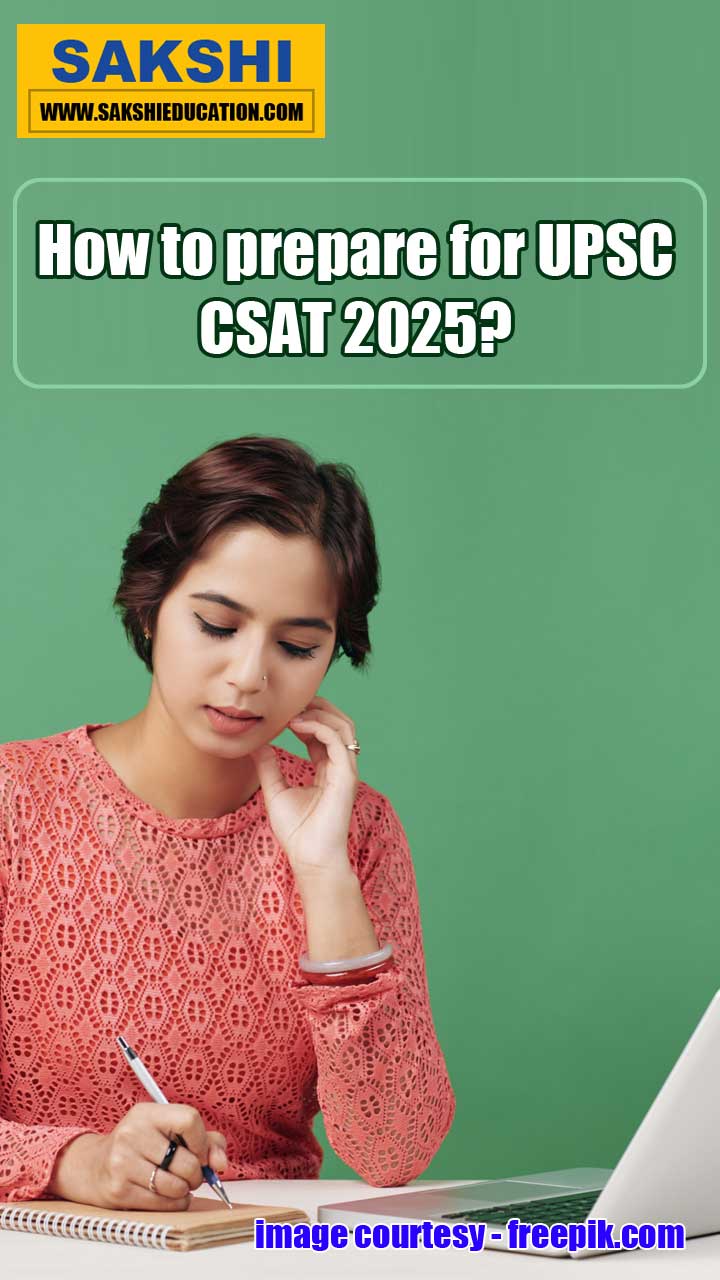Staff Selection Commission – Combined Graduate Examination (Tier-I&II) Syllabus
Sakshi Education
The Scheme of the Examination will be conducted in three tiers as indicated below:
Indicative Syllabus for Tier-I of the Examination :
(A) General Intelligence & Reasoning: It would include questions of both verbal and nonverbal type. This component may include questions on analogies, similarities and differences, space visualization, spatial orientation, problem solving, analysis, judgment, decision making, visual memory, discrimination, observation, relationship concepts, arithmetical reasoning and figural classification, arithmetic number series, non-verbal series, coding and decoding, statement conclusion, syllogistic reasoning etc. The topics are, Semantic Analogy, Symbolic/Number Analogy, Figural Analogy, Semantic Classification, Symbolic/Number Classification, Figural Classification, Semantic Series, Number Series, Figural Series, Problem Solving, Word Building, Coding & de-coding, Numerical Operations, symbolic Operations, Trends, Space Orientation, Space Visualization, Venn Diagrams, Drawing inferences, Punched hole/pattern –folding & unfolding, Figural Pattern – folding and completion, Indexing, Address matching, Date & city matching, Classification of centre codes/roll numbers, Small & Capital letters/numbers coding, decoding and classification, Embedded Figures, Critical thinking, Emotional Intelligence, Social Intelligence, Other sub-topics, if any.
(B) General Awareness: Questions in this component will be aimed at testing the candidate’s general awareness of the environment around him and its application to society. Questions will also be designed to test knowledge of current events and of such matters of every day observations and experience in their scientific aspect as may be expected of any educated person. The test will also include questions relating to India and its neighboring countries especially pertaining History, Culture, Geography, Economic Scene, General Polity, Indian Constitution and Scientific Research etc.
These Questions will be such that they do not require a special study of any discipline.
(C) Quantitative Aptitude: The questions will be designed to test the ability of appropriate use of numbers and number sense of the candidate. The scope of the test will be computation of whole numbers, decimals, fractions and relationships between numbers, Percentage. Ratio & Proportion, Square roots, Averages, Interest, Profit and Loss, Discount, Partnership Business, Mixture and Alligation, Time and distance, Time & Work, Basic algebraic identities of School Algebra & Elementary surds, Graphs of Linear Equations, Triangle and its various kinds of centres, Congruence and similarity of triangles, Circle and its chords, tangents, angles subtended by chords of a circle, common tangents to two or more circles, Triangle, Quadrilaterals, Regular Polygons, Circle, Right Prism, Right Circular Cone, Right Circular Cylinder, Sphere, Hemispheres, Rectangular Parallelepiped, Regular Right Pyramid with triangular or square base, Trigonometric ratio, Degree and Radian Measures, Standard Identities, Complementary angles, Heights and Distances, Histogram, Frequency polygon, Bar diagram & Pie chart
(D) English Comprehension: Candidates’ ability to understand correct English, his basic Comprehension and writing ability, etc. would be tested.
Indicative Syllabus for Tier-II of the Examination:
Tier-II of the Combined Graduate Level Examination will be of Objective Type Multiple Choice and will be conducted over two days during a weekend. It will consist of three different papers/subjects and depending upon the category of posts applied for, the candidate will be required to appear in one, two or three papers, as the case may be.
Paper-I:
Arithmetic Abilities: The questions will be designed to test the ability of appropriate use of numbers and number sense of the candidate. The scope of the test will be the computation of whole numbers, decimals, fractions and relationships between numbers, Percentage. Ratio & Proportion, Square roots, Averages, Interest, Profit and Loss, Discount, Partnership Business, Mixture and Alligation, Time and distance, Time & Work, Basic algebraic identities of School Algebra & Elementary surds, Graphs of Linear Equations, Triangle and its various kinds of centres, Congruence and similarity of triangles, Circle and its chords, tangents, angles subtended by chords of a circle, common tangents to two or more circles, Triangle, Quadrilaterals, Regular Polygons , Circle, Right Prism, Right Circular Cone, Right Circular Cylinder, Sphere, Hemispheres, Rectangular Parallelepiped, Regular Right Pyramid with triangular or square base, Trigonometric ratio, Degree and Radian Measures, Standard Identities, Complementary angles, Heights and Distances, Histogram, Frequency polygon, Bar diagram & Pie chart
Paper-II:
English Language & Comprehension: Questions in this components will be designed to test the candidate’s understanding and knowledge of English Language and will be based on error recognition, fill in the blanks (using verbs, preposition, articles etc), Vocabulary, Spellings, Grammar, Sentence Structure, Synonyms, Antonyms, Sentence Completion, Phrases and Idiomatic use of Words, etc. There will be a question on passages and comprehension of passages also. (The standard of the questions will be of 10+2 level).
Paper-III: Commerce/Mathematics/Statistics/Economics for Investigator Grade-II, for Ministry of Statistics & Programme Implementation and Compiler for Registrar General of India, Ministry of Home Affairs.
STATISTICS
Collection Classification and Presentation of Statistical Data – Primary and Secondary data, Methods of data collection; Tabulation of data; Graphs and charts; Frequency distributions; Diagrammatic presentation of frequency distributions.
Measures of Central Tendency- Common measures of central tendency – mean median and mode; Partition values- quartiles, deciles, percentiles.
Measures of Dispersion- Common measures dispersion – range, quartile deviations, mean deviation and standard deviation; Measures of relative dispersion.
Moments, Skewness and Kurtosis – Different types of moments and their relationship; meaning of skewness and kurtosis; different measures of skewness and kurtosis.
Correlation and Regression – Scatter diagram; simple correlation coefficient; simple regression lines; Spearman’s rank correlation; Measures of association of attributes; Multiple regression; Multiple and partial correlation (For three variables only).
Probability Theory – Meaning of probability; Different definitions of probability; Conditional probability; Compound probability; Independent events; Bayes’ theorem.
Random Variable and Probability Distributions – Random variable; Probability functions; Expectation and Variance of a random variable; Higher moments of a random variable; Binomial, Poisson, Normal and Exponential distributions; Joint distribution of two random variable (discrete).
Sampling Theory – Concept of population and sample; Parameter and statistic, Sampling and non-sampling errors; Probability and non-probability sampling techniques (simple random sampling, stratified sampling, multistage sampling, multiphase sampling, cluster sampling, systematic sampling, purposive sampling, convenience sampling and quota sampling); Sampling distribution (statement only); Sample size decisions.
Statistical Inference - Point estimation and interval estimation, Properties of a good estimator, Methods of estimation (Moments method, Maximum likelihood method, Least squares method), Testing of hypothesis, Basic concept of testing, Small sample and large sample tests, Tests based on Z, t, Chi-square and F statistic, Confidence intervals.
Analysis of Variance - Analysis of one-way classified data and two-way classified data.
Time Series Analysis - Components of time series, Determinations of trend component by different methods, Measurement of seasonal variation by different methods.
Index Numbers - Meaning of Index Numbers, Problems in the construction of index numbers, Types of index number, Different formulae, Base shifting and splicing of index numbers, Cost of living Index Numbers, Uses of Index Numbers.
NOTE-I: Questions in Paper-I will be of 10th standard level, Paper-II of 10+2 level and Paper-III of graduation level.
ECONOMICS
General Economics
MATHEMATICS
Algebra: Algebra of sets, relations and functions, Inverse of a function, equivalence relation. The system of complex numbers, De Moivere’s Theorem and its simple applications. Relation between roots and coefficients of a polynomial equation – Evaluation of symmetric function of roots of cubic and biquadratic equation.
Algebra of Matrices: Determinants, Simple properties of determinants, Multiplication of determinants of orders two and three, Singular and non-singular matrices. Inverse of a matrix, Rank of a matrix and application of matrices to the solution of linear equations ( in three unknowns ).
Convergence of sequences, and series, tests of convergence of series with positive terms, Ratio, Root and Gauss tests.
Analytic Geometry: Straight lines, Circles, System of circles, parabola, ellipse and hyperbola in standard form and their elementary properties, Classification of curves second degree.
Differential Equation: First order differential equation. Solution of Second and higher order linear differential equations with constant coefficients and simple applications.
Differential and Integral Calculus: Limit, continuity and differentiability of functions, successive differentiation, derivatives of standard functions, Rolle’s and Mean-value Theorems, Maclaurins and Taylor’s series ( without proof) and their applications, Maxima and Minima of functions of one and two variables. Tangents and Normals, Curvature, Partial differentiation, Euler’s theorem for homogeneous function, Tracing of curves.
Standard methods of integration, Riemann’s definition of definite integral, fundamental theorem of integral calculus, quadrature, rectification, volumes and surface area of solids of revolution.
Statistics: Frequency distributions, Measures of central tendency, measures of dispersion, Skewness and Kurtosis, Random variables and distribution function, Discrete distributions, Binomial and Poisson distribution, continuous distributions, Rectangular, Normal and Exponential distributions, Principles of least squares, correlation and regression, Random Sampling, random numbers, Sampling of attributes, Large Sample tests for mean and proportion, Tests of significance based on t, F and Chi-square distributions.
COMMERCE
This paper will cover all the subjects of commerce ordinarily taught at the B.Com. or similar degree courses of Indian Universities. Specifically, it will include the following subjects:
Accountancy: Conceptual framework, Income measurement, Final accounts, Accounting for partnership firms, Hire-purchase accounting, Corporate accounting (Issue, forfeiture and re-issue of shares).
Business Organisation: Business objectives, Business environment, Business entrepreneurship (including location, choice of form of business and growth strategies), Business operations including finance, production, marketing and human resource development.
Management: Concept of management, Planning, Organising, Leading and Controlling.
Micro-economics: Price-mechanism, Theory of consumer behaviour, Elasticity of demand, Production function, Theory of costs, Market structures, Price-determination under perfect competition and monopoly.
Indian Economics: Issues involved in planning for economic development, Sectoral analysis of Indian economy including agriculture, industry and foreign trade.
Business Statistics: Analysis of Univariate data involving measurement of Central tendency and dispersion, correlation and regression analysis, index numbers, analysis of time-series, Theory of probability.
Business Law: Indian Contract Act, 1872, Sale of Goods Act, 1930, Partnership Act, 1932 and Negotiable Instruments Act, 1881.
Company Law: Kinds of companies, matters involving incorporation of company, shares and share capital and matters relating to issue and transfers of shares, members of a company, management of a company, meetings and resolutions, winding up of a company.
Cost accounting: Procedures involved in cost accounting, marginal costing, cost-volume profit analysis, Budgetary control, Standard costing.
Auditing: Meaning and objects of auditing, Types of audit, Audit process.
Income Tax: Basic concepts, Residence and tax liability, heads of income.
| 1st Tier | Written Examination (Objective Multiple Choice Type) |
| 2nd Tier | Main Written Examination (Objective Multiple Choice Type) |
| 3rd Tier | Personality Test /Interview or Skill Test, where applicable |
| (Candidates opting for post of Sub-Inspector in CPOs will be required to undergo Physical Endurance Test (PET)/Medical Examination at any convenient time after declaration of result of Tier I.) |
Indicative Syllabus for Tier-I of the Examination :
(A) General Intelligence & Reasoning: It would include questions of both verbal and nonverbal type. This component may include questions on analogies, similarities and differences, space visualization, spatial orientation, problem solving, analysis, judgment, decision making, visual memory, discrimination, observation, relationship concepts, arithmetical reasoning and figural classification, arithmetic number series, non-verbal series, coding and decoding, statement conclusion, syllogistic reasoning etc. The topics are, Semantic Analogy, Symbolic/Number Analogy, Figural Analogy, Semantic Classification, Symbolic/Number Classification, Figural Classification, Semantic Series, Number Series, Figural Series, Problem Solving, Word Building, Coding & de-coding, Numerical Operations, symbolic Operations, Trends, Space Orientation, Space Visualization, Venn Diagrams, Drawing inferences, Punched hole/pattern –folding & unfolding, Figural Pattern – folding and completion, Indexing, Address matching, Date & city matching, Classification of centre codes/roll numbers, Small & Capital letters/numbers coding, decoding and classification, Embedded Figures, Critical thinking, Emotional Intelligence, Social Intelligence, Other sub-topics, if any.
(B) General Awareness: Questions in this component will be aimed at testing the candidate’s general awareness of the environment around him and its application to society. Questions will also be designed to test knowledge of current events and of such matters of every day observations and experience in their scientific aspect as may be expected of any educated person. The test will also include questions relating to India and its neighboring countries especially pertaining History, Culture, Geography, Economic Scene, General Polity, Indian Constitution and Scientific Research etc.
These Questions will be such that they do not require a special study of any discipline.
(C) Quantitative Aptitude: The questions will be designed to test the ability of appropriate use of numbers and number sense of the candidate. The scope of the test will be computation of whole numbers, decimals, fractions and relationships between numbers, Percentage. Ratio & Proportion, Square roots, Averages, Interest, Profit and Loss, Discount, Partnership Business, Mixture and Alligation, Time and distance, Time & Work, Basic algebraic identities of School Algebra & Elementary surds, Graphs of Linear Equations, Triangle and its various kinds of centres, Congruence and similarity of triangles, Circle and its chords, tangents, angles subtended by chords of a circle, common tangents to two or more circles, Triangle, Quadrilaterals, Regular Polygons, Circle, Right Prism, Right Circular Cone, Right Circular Cylinder, Sphere, Hemispheres, Rectangular Parallelepiped, Regular Right Pyramid with triangular or square base, Trigonometric ratio, Degree and Radian Measures, Standard Identities, Complementary angles, Heights and Distances, Histogram, Frequency polygon, Bar diagram & Pie chart
(D) English Comprehension: Candidates’ ability to understand correct English, his basic Comprehension and writing ability, etc. would be tested.
Indicative Syllabus for Tier-II of the Examination:
Tier-II of the Combined Graduate Level Examination will be of Objective Type Multiple Choice and will be conducted over two days during a weekend. It will consist of three different papers/subjects and depending upon the category of posts applied for, the candidate will be required to appear in one, two or three papers, as the case may be.
Paper-I:
Arithmetic Abilities: The questions will be designed to test the ability of appropriate use of numbers and number sense of the candidate. The scope of the test will be the computation of whole numbers, decimals, fractions and relationships between numbers, Percentage. Ratio & Proportion, Square roots, Averages, Interest, Profit and Loss, Discount, Partnership Business, Mixture and Alligation, Time and distance, Time & Work, Basic algebraic identities of School Algebra & Elementary surds, Graphs of Linear Equations, Triangle and its various kinds of centres, Congruence and similarity of triangles, Circle and its chords, tangents, angles subtended by chords of a circle, common tangents to two or more circles, Triangle, Quadrilaterals, Regular Polygons , Circle, Right Prism, Right Circular Cone, Right Circular Cylinder, Sphere, Hemispheres, Rectangular Parallelepiped, Regular Right Pyramid with triangular or square base, Trigonometric ratio, Degree and Radian Measures, Standard Identities, Complementary angles, Heights and Distances, Histogram, Frequency polygon, Bar diagram & Pie chart
Paper-II:
English Language & Comprehension: Questions in this components will be designed to test the candidate’s understanding and knowledge of English Language and will be based on error recognition, fill in the blanks (using verbs, preposition, articles etc), Vocabulary, Spellings, Grammar, Sentence Structure, Synonyms, Antonyms, Sentence Completion, Phrases and Idiomatic use of Words, etc. There will be a question on passages and comprehension of passages also. (The standard of the questions will be of 10+2 level).
Paper-III: Commerce/Mathematics/Statistics/Economics for Investigator Grade-II, for Ministry of Statistics & Programme Implementation and Compiler for Registrar General of India, Ministry of Home Affairs.
STATISTICS
Collection Classification and Presentation of Statistical Data – Primary and Secondary data, Methods of data collection; Tabulation of data; Graphs and charts; Frequency distributions; Diagrammatic presentation of frequency distributions.
Measures of Central Tendency- Common measures of central tendency – mean median and mode; Partition values- quartiles, deciles, percentiles.
Measures of Dispersion- Common measures dispersion – range, quartile deviations, mean deviation and standard deviation; Measures of relative dispersion.
Moments, Skewness and Kurtosis – Different types of moments and their relationship; meaning of skewness and kurtosis; different measures of skewness and kurtosis.
Correlation and Regression – Scatter diagram; simple correlation coefficient; simple regression lines; Spearman’s rank correlation; Measures of association of attributes; Multiple regression; Multiple and partial correlation (For three variables only).
Probability Theory – Meaning of probability; Different definitions of probability; Conditional probability; Compound probability; Independent events; Bayes’ theorem.
Random Variable and Probability Distributions – Random variable; Probability functions; Expectation and Variance of a random variable; Higher moments of a random variable; Binomial, Poisson, Normal and Exponential distributions; Joint distribution of two random variable (discrete).
Sampling Theory – Concept of population and sample; Parameter and statistic, Sampling and non-sampling errors; Probability and non-probability sampling techniques (simple random sampling, stratified sampling, multistage sampling, multiphase sampling, cluster sampling, systematic sampling, purposive sampling, convenience sampling and quota sampling); Sampling distribution (statement only); Sample size decisions.
Statistical Inference - Point estimation and interval estimation, Properties of a good estimator, Methods of estimation (Moments method, Maximum likelihood method, Least squares method), Testing of hypothesis, Basic concept of testing, Small sample and large sample tests, Tests based on Z, t, Chi-square and F statistic, Confidence intervals.
Analysis of Variance - Analysis of one-way classified data and two-way classified data.
Time Series Analysis - Components of time series, Determinations of trend component by different methods, Measurement of seasonal variation by different methods.
Index Numbers - Meaning of Index Numbers, Problems in the construction of index numbers, Types of index number, Different formulae, Base shifting and splicing of index numbers, Cost of living Index Numbers, Uses of Index Numbers.
NOTE-I: Questions in Paper-I will be of 10th standard level, Paper-II of 10+2 level and Paper-III of graduation level.
ECONOMICS
General Economics
- Demand and Supply Analysis, including Laws and Interaction of Demand and Supply.
- Production Function and Laws of Returns.
- Commodity Pricing – Characteristics of various Market Forms and Price Determination under such Market Forms.
- Theory of Factor Pricing – Rent, Wage, Interest and Profit.
- Theory of Employment – Classical and Neo-classical Approach.
- Keynesian Theory of Employment – Principles of Effective Demand. Meaning and Importance of Investment, Relation between Saving and Investment, Multiplier Effect and the process of Income Generation, Post Keynesian Development.
- Nature and Functions of Money, Value of Money, Fluctuations in the value of Money – Inflation and Deflation, Monetary Policy, Index Number.
- International Trade-Free Trade and Protection, Theories of International Trade.
- Foreign Exchange – Determination of the rate of Exchange – Purchasing Power Parity theory and Balance of Payment Theory.
- Public Finance – Nature. Scope and importance of Public Finance.
- Taxation – Meaning, Classification and Principles of Taxation, Incidence of Taxation.
- Deficit Financing.
- Fiscal Policy.
- Statistical Investigation – Meaning and Planning of Investigation.
- Collection of data and editing of data.
- Types of sampling.
- Schedule and questionnaire.
- Presentation of data – classification, tabulation, etc.
- Measures of Central Tendency.
- National Income and Accounting – Estimation of National Income, Trends in National Income, Structural changes in the Indian Economy as seen in National Income Data.
- Agricultural sector – Agricultural Development during Plan Period, Rural Credit, Agricultural Price Policy, Rural Development Co-operation and Panchayati Raj.
- Industrial Policy and Industrial Development.
- Problems of Economic Development – Indian Planning – Objectives, Techniques and its evolution, Five Year Plans and Role of National Development Council.
- Profile of Human Resources – Population and Economic Development, Demographic Profile of India, Nature of Population Problem – Poverty, Inequality, Unemployment Problem, Labour Problem, Population Control and Government Policy.
- New Economic Policy and Welfare Schemes.
- Indian Public Finance – Indian Revenue, Foreign Aid.
- Indian Banking and Currency system.
MATHEMATICS
Algebra: Algebra of sets, relations and functions, Inverse of a function, equivalence relation. The system of complex numbers, De Moivere’s Theorem and its simple applications. Relation between roots and coefficients of a polynomial equation – Evaluation of symmetric function of roots of cubic and biquadratic equation.
Algebra of Matrices: Determinants, Simple properties of determinants, Multiplication of determinants of orders two and three, Singular and non-singular matrices. Inverse of a matrix, Rank of a matrix and application of matrices to the solution of linear equations ( in three unknowns ).
Convergence of sequences, and series, tests of convergence of series with positive terms, Ratio, Root and Gauss tests.
Analytic Geometry: Straight lines, Circles, System of circles, parabola, ellipse and hyperbola in standard form and their elementary properties, Classification of curves second degree.
Differential Equation: First order differential equation. Solution of Second and higher order linear differential equations with constant coefficients and simple applications.
Differential and Integral Calculus: Limit, continuity and differentiability of functions, successive differentiation, derivatives of standard functions, Rolle’s and Mean-value Theorems, Maclaurins and Taylor’s series ( without proof) and their applications, Maxima and Minima of functions of one and two variables. Tangents and Normals, Curvature, Partial differentiation, Euler’s theorem for homogeneous function, Tracing of curves.
Standard methods of integration, Riemann’s definition of definite integral, fundamental theorem of integral calculus, quadrature, rectification, volumes and surface area of solids of revolution.
Statistics: Frequency distributions, Measures of central tendency, measures of dispersion, Skewness and Kurtosis, Random variables and distribution function, Discrete distributions, Binomial and Poisson distribution, continuous distributions, Rectangular, Normal and Exponential distributions, Principles of least squares, correlation and regression, Random Sampling, random numbers, Sampling of attributes, Large Sample tests for mean and proportion, Tests of significance based on t, F and Chi-square distributions.
COMMERCE
This paper will cover all the subjects of commerce ordinarily taught at the B.Com. or similar degree courses of Indian Universities. Specifically, it will include the following subjects:
Accountancy: Conceptual framework, Income measurement, Final accounts, Accounting for partnership firms, Hire-purchase accounting, Corporate accounting (Issue, forfeiture and re-issue of shares).
Business Organisation: Business objectives, Business environment, Business entrepreneurship (including location, choice of form of business and growth strategies), Business operations including finance, production, marketing and human resource development.
Management: Concept of management, Planning, Organising, Leading and Controlling.
Micro-economics: Price-mechanism, Theory of consumer behaviour, Elasticity of demand, Production function, Theory of costs, Market structures, Price-determination under perfect competition and monopoly.
Indian Economics: Issues involved in planning for economic development, Sectoral analysis of Indian economy including agriculture, industry and foreign trade.
Business Statistics: Analysis of Univariate data involving measurement of Central tendency and dispersion, correlation and regression analysis, index numbers, analysis of time-series, Theory of probability.
Business Law: Indian Contract Act, 1872, Sale of Goods Act, 1930, Partnership Act, 1932 and Negotiable Instruments Act, 1881.
Company Law: Kinds of companies, matters involving incorporation of company, shares and share capital and matters relating to issue and transfers of shares, members of a company, management of a company, meetings and resolutions, winding up of a company.
Cost accounting: Procedures involved in cost accounting, marginal costing, cost-volume profit analysis, Budgetary control, Standard costing.
Auditing: Meaning and objects of auditing, Types of audit, Audit process.
Income Tax: Basic concepts, Residence and tax liability, heads of income.
Published date : 04 Dec 2015 01:07PM













